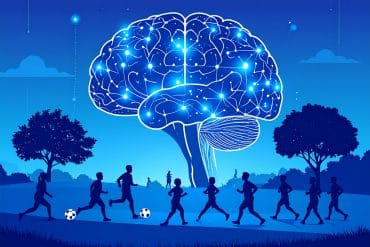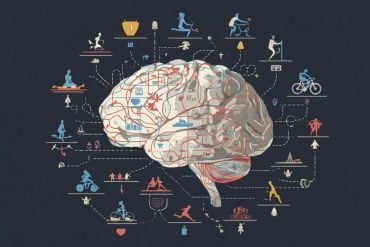Summary: Researchers have examined the sequence of more than 650 genes associated with autism and discovered characteristics that distinguish them from other brain specific genes.
Source: American Associates Ben-Gurion University.
Ben-Gurion University of the Negev (BGU) researchers are a step closer to understanding the genetic basis of autism, which they hope will lead to earlier diagnosis of what is rapidly becoming the most prevalent developmental disorder worldwide.
In the study published in Behavior Genetics, the researchers examined the sequences of more than 650 genes associated with autism and discovered characteristics that distinguish them from other brain-specific genes and genes of other diseases.
According to the U.S. Centers for Disease Control and Prevention (CDC), one in 50 children in the United States is diagnosed with autism, a neurodevelopmental disorder which can severely impair communication and social skills. These figures have skyrocketed since the 1980s, when only one in 5,000 were diagnosed with an autism spectrum disorder (ASD).
“We are now a step closer to understanding the genes associated with autism and understanding the biological process involved in the disease,” says Dr. Idan Menashe, who along with his colleagues, Erez Tsur and Prof. Michael Friger, is a member of the BGU Department of Public Health in the Faculty of Health Sciences. Dr. Menashe and Tsur are also members of BGU’s Zlotowski Center for Neuroscience.
“This study gives us a tool to help identify additional autism genes using the genetic signature we found. From there, we hope to be able to diagnose autism earlier,” the researchers say.
One particularly distinct characteristic of autism genes the researchers found is their exceptional genomic length, which is longer than other brain-expressed genes of closely related diseases such as Alzheimer’s and schizophrenia.
Additionally, when the researchers studied families that have a child diagnosed with ASD, they found a unique genomic signature shaped by negative selection, an evolutionary process that purifies and removes disruptive mutations from genes and prevents them from replicating over generations.

Dr. Menashe and his colleagues also searched for evidence of positive selection in these genes, which would cause an increase in frequency until they are a factor in the population. “While this kind of mechanism could explain the prevalence of autism in the human population, we found no indications of positive selection acting on autism genes,” he says. “Thus, while autism susceptibility mutations are in the human genome, they only present as an autism disorder when combined with other genetic, non-genetic or environmental factors.
“Our findings suggest that ASD genes have evolved under complex evolutionary forces, which have left a unique signature that can be used to identify new ASD candidate genes,” the researchers add.
Source: Andrew Lavin – American Associates Ben-Gurion University
Image Source: NeuroscienceNews.com image is in the public domain.
Original Research: Abstract for “The Unique Evolutionary Signature of Genes Associated with Autism Spectrum Disorder” by Erez Tsur, Michael Friger, andIdan Menashe in Behavior Genetics. Published online August 11 2016 doi:10.1007/s10519-016-9804-4
[cbtabs][cbtab title=”MLA”]American Associates Ben-Gurion University. “Possible Genetic Basis for Autism Discovered.” NeuroscienceNews. NeuroscienceNews, 8 October 2016.
<https://neurosciencenews.com/autism-genetic-basis-5241/>.[/cbtab][cbtab title=”APA”]American Associates Ben-Gurion University. (2016, October 8). Possible Genetic Basis for Autism Discovered. NeuroscienceNews. Retrieved October 8, 2016 from https://neurosciencenews.com/autism-genetic-basis-5241/[/cbtab][cbtab title=”Chicago”]American Associates Ben-Gurion University. “Possible Genetic Basis for Autism Discovered.” https://neurosciencenews.com/autism-genetic-basis-5241/ (accessed October 8, 2016).[/cbtab][/cbtabs]
Abstract
The Unique Evolutionary Signature of Genes Associated with Autism Spectrum Disorder
Autism spectrum disorder (ASD) is a common heritable neurodevelopmental disorder, which is characterized by communication and social deficits that reduce the reproductive fitness of individuals with the disorder. Here, we studied the genomic characteristics of 651 ASD genes in a whole-exome sequencing dataset, to search for traces of the evolutionary forces that helped maintain ASD in the human population. We show that ASD genes are ~65 longer and ~20 % less variable than non-ASD genes. The mutational shortage in ASD genes was particularly eminent when considering only deleterious genetic variations, which is a hallmark of negative selection. We further show that these genomic characteristics are unique to ASD genes, as compared with brain-specific genes or with genes of other diseases. Our findings suggest that ASD genes have evolved under complex evolutionary forces, which have left a unique signature that can be used to identify new candidate ASD genes.
“The Unique Evolutionary Signature of Genes Associated with Autism Spectrum Disorder” by Erez Tsur, Michael Friger, andIdan Menashe in Behavior Genetics. Published online August 11 2016 doi:10.1007/s10519-016-9804-4







